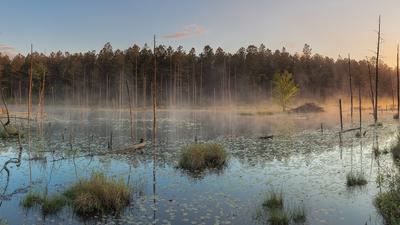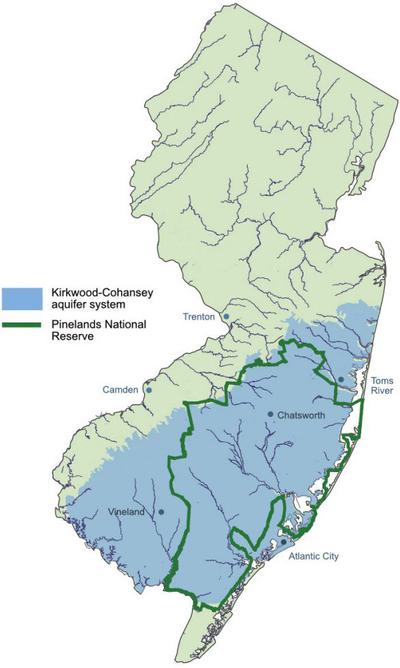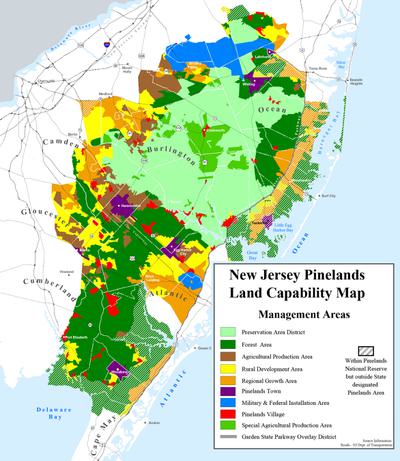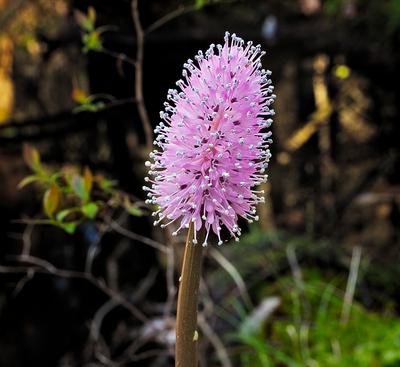The Kirkwood-Cohansey Aquifer runs under nearly one-third of New Jersey. Pinelands Preservation Alliance
The rare swamp pink plant, as well as pitcher plants and sundew — both carnivorous — thrive in the aquifer’s highly acidic water. In some places the aquifer is so shallow that it provides water directly to the roots of pitch pine and cedar, whose dense forests shelter secretive species such as timber rattlesnakes and the rare Pine Barrens tree frog. The Kirkwood-Cohansey also provides water for surrounding upland agriculture and for the Pinelands’ commercial cranberry bogs and blueberry farms, as well as one million South Jersey residents.
A lesson on the effects of runaway development on an unconfined aquifer lies only 150 miles northeast, on Long Island, New York. As it does along New Jersey’s coastal plain, Long Island’s unconfined aquifer, known as the Upper Glacial, provides both groundwater and surface water. The aquifer once supplied nearly all of Long Island’s drinking water, but by the mid-1950s the Upper Glacial was already contaminated by nitrates, detergents, and synthetic organic compounds, the result of unrelenting suburban and industrial growth and agriculture Now, virtually all of Long Island’s residents who do not live in New York City, some 3 million people, take their water from the subterranean Magothy Aquifer.
The same period saw Long Island’s Pine Barrens diminish. Like New Jersey’s Pinelands, they are part of the coastal Pinelands ecoregion that once stretched from Delaware north to Cape Cod, Massachusetts. Unlike New Jersey’s Pinelands, however, Long Island’s remained unprotected until 1993 when New York State passed the Similar to New Jersey’s Pinelands Reserve, it set aside some 100,000 acres to protect the 55,000 acres of core Pine Barrens remaining — reduced from an original quarter-million acres.
A challenge for the Pinelands is the difficulty of isolating aquifers from the impacts of perimeter development and agriculture.
A challenge for the pinelands in Long Island and New Jersey is the difficulty of isolating aquifers — even beneath protected land — from the impacts of perimeter development and agriculture. A 2014 report on New Jersey’s Pinelands Reserve found that despite the success in protecting 600,000 acres of Pinelands, the Kirkwood-Cohansey was still being affected by runoff from past and present development, agriculture, and septic systems.
As areas on the perimeter of the Pinelands reserve set aside for development increase in population, so will concerns over non-point sources of contamination. But perhaps most damaging are the increasing residential demands for water from a system that, as Rich Bizub, director of water programs for the Pinelands Preservation Alliance, puts it, “is pretty tapped out.”
The New Jersey Department of Environmental Protection (DEP) maintains that the state “has sufficient water available to meet its needs into the foreseeable future.” But as Bizub and Larry Liggett, the Pinelands Commission’s director of land use and technology, see it, when it comes to the Kirkwood-Cohansey Aquifer this optimistic projection is only true on the very crudest scale. The details, says Bizub, show that the DEP has allocated more water than it should have. Residential development on the Pinelands’ borders in the Burlington and Ocean counties, along with agricultural withdrawals in the interior, have pushed the aquifer to its limits.
“If everyone uses up their full allocations, the situation is bleak,” says Bizub. Further, the state does not look at water withdrawals on a sufficiently fine scale to assess their ecological effects, he says.
A map of development and land use within and around the Pinelands National Reserve. Click image to enlarge.
This concern is especially relevant in groundwater-dependent ecosystems (called GDEs) such as the Pinelands, where water withdrawals can quickly alter the hydrology, and leave plants and tree roots high and dry. These valuable ecosystems, writes Melissa Rohde, a groundwater scientist with California’s Nature Conservancy, support biodiversity, provide base flows in rivers, water purification, pollinator habitat, flood control, and water supply. And yet, she writes, “Globally, GDEs are increasingly threatened as human exploitation often exceeds natural recharge rates, particularly in Asia and North America.”
While there are few places that legislate consideration of GDEs in water management plans, California’s Sustainable Groundwater Management Act required that local 5-year groundwater sustainability plans must identify and consider impacts to GDEs. Australia, says Rohde, has the most advanced policies with regard to protecting GDEs, driven by increasing demand from economic development and growing water stress from climate change. Groundwater provides some 30 percent of Australia’s water needs, and as much as 60 percent in the country’s drought-prone southwest.
The challenge, says Rohde, is knowing the thresholds at which effects occur and then quantifying those effects, which requires costly studies involving hydrologists, geologists, and ecologists.
As it happens, just such an expensive study — $5.5 million— occurred in New Jersey in 2003 when state, federal and academic researchers began investigating the effects on the Pinelands ecosystem of water withdrawals from the Kirkwood-Cohansey Aquifer.
In his study of the hydrologic effects, Robert S. Nicholson, then with the U.S. Geological Survey, modeled simulated water withdrawals of 5 to 30 percent of the aquifer’s overall recharge in three Pinelands drainage basins. The result was that even the smallest withdrawal could result in as much as a six-inch decline in water levels over as much as 10 percent of the total wetland area, while at the same time reducing base stream flow by as much as 9 percent. Withdrawing 30 percent of the aquifer’s recharge could result in a near-total loss of wetlands.
The Pineland Commission’s own ecological study simulated groundwater withdrawals to predict the effects of these reduced flows on stream insects and fish, and on shallower wetland habitats.
“When we played with the simulations on pond plant communities we found some species sensitive to even the smallest reduction in water depth,” says Kim Laidig, the Pinelands Commission’s principal research scientist. A six-inch drawdown left more than 30 percent of the endangered swamp pink plant exposed to “extreme hydrologic conditions.” Twice that drawdown would virtually wipe out the species.
Only once you establish an acceptable threshold of change can you provide a margin of safety by setting a water withdrawal “speed limit.”
Some species such as the deciduous shrub, leatherleaf, and highbush blueberry might prove more resilient. But as groundwater levels continue to decline, wetland forests begin to change, with cedar and hardwood swamps giving way to upland pine-oak forests and pitch-pine lowlands.
That same six-inch drawdown also affected the life cycles of Pinelands amphibians such as the southern leopard frog, northern spring peeper, and Pine Barrens tree frog, whose spring-hatched larvae require intermittent wetlands to have sufficient water into early summer.
Nicholson points out that the exact impacts of water withdrawals will depend upon a watershed’s topography, hydrology, and carrying capacity. The Pinelands alone has 223 subwatersheds. Some will prove more vulnerable. Nicholson says that only once you establish an acceptable threshold of change can you provide a margin of safety by setting what he calls a water withdrawal “speed limit.”
What the Kirkwood-Cohansey studies showed, says Bizub, is that “by the time you see the loss of flow in streams you have already really trashed a lot of wetlands. In many places in the Pinelands, that 5 to 10 percent drawdown has already been surpassed.”
And yet, years after the completion of these extensive Kirkwood-Cohansey studies, neither the state nor the Pinelands Commission has acted upon any of the findings. Indeed, what Governor Christie has made clear through his appointees on the Pinelands Commission is that approval of two new natural gas pipelines is a priority.
The rare swamp pink plant thrives in the Kirkwood-Cohansey Aquifer’s highly acidic water. Courtesy of Albert D. Horner
In February, the commission — over protests that included a letter from four previous New Jersey governors, Republican and Democrat — approved a pipeline that would traverse 22 miles of Pinelands. The Sierra Club and the Pinelands Preservation Alliance immediately brought suit against the commission. Pipeline supporters and protesters engaged again at a July 26 hearing on a second, 30-mile pipeline that would run adjacent to sensitive Pinelands preservation land. The legal issues focus on whether the Commission’s decisions run counter to the mandates of the reserve’s comprehensive management plan. The environmental issues focus on the risks that pipeline construction, maintenance, or leaks might pose to local residents, the Pinelands ecosystem, and the Kirkwood-Cohansey Aquifer.
Meanwhile, says Bizub, the state DEP continues to over-allocate water supplies. For instance, in the southernmost extent of the Kirkwood-Cohansey aquifer that provides water to the Maurice River, virtually every watershed is stressed. Next to the Delaware River itself, the Maurice is Delaware Bay’s largest freshwater tributary. The shortage of stream flow has allowed saltwater to infiltrate into the freshwater aquifer.
Right now, says Liggett, the Pineland’s Commission’s rules for dealing with water withdrawals are vague. “They require that there be ‘no adverse impact,’ but what does that mean? How is it measured? A foot of drawdown in a wetland is easy to measure. But six inches? Three inches?”
The Kirkwood-Cohansey studies made clear the links between the aquifer and the ecosystem, says Bizub. Now the question is whether the political will exists to deal with its implications — in particular, the possibility of limits on growth.
“We keep sending proposals and recommendations for new rules to the governor’s office,” says Liggett. “But we get no answers.”






